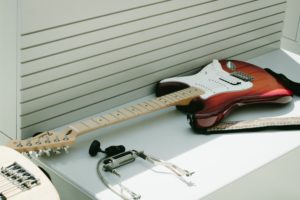If you have an electric guitar you will know the strings get rusted easily. Especially if the instrument is left open to the humidity of the environment for too long.
Excess use of the machine also sometimes leads to rusting. There is not much of an escape from degrading guitar strings over time.
IF you have been starting your journey with your electric guitar, it is common not to know how to change electric guitar strings.
Professionals in this department usually change their guitar strings every week or so.
What are the signs that tell you that you need to know how to change electric guitar strings?
If you see that your guitar cords are rusting, you might need to change the guitar strings. As discussed earlier, excessive use and underuse can cause the instruments to rust. Even the storing conditions can cause the apparatus to rust. Humidity is a dominant cause of the deterioration of several appliances, including but not limited to electric guitars.
If you notice that you are having to change the tuning frequently, it might be time to change the strings. When you find that you are having to handle the tuning of your electric guitar, what is possibly happening is that your strings have lost the pliability that they once had. Because of this, they might be shifting from the grip more and more easily. This issue is only going to be more and more prominent over time.
If you notice your guitar strings getting grimy and slippery, then it is time to change them. This happens for no fault of the string itself. You need to take better care of your instruments in this case. Leaving them open in the air and not cleaning them, over time is going to lead to a major buildup of dust, dirt, and unction on the strings. This is in no way good for the strings.
Here is how to change electric guitar strings
- Note the positions of each string before you decide to take them off. There are specific paths that the strings follow, and just before they are strung to the keys, they go through separate grooves. If you need, mark the scores. These will later guide you when you re-string the guitar.
- Some guitars have intricated threading guides to provide the cords with enough surface area to grip the keys and stay tuned. Always note these patterns.
- Turn the keys at the top of the guitar. If you are new to the procedure, unscrew one key at a time. Be very careful, and put one of your fingers on the string you are unwinding. This will allow you to feel if the line is getting looser or tighter. Never arbitrarily continue turning the key, If you cannot feel any change in the tension of the cord.
- Once you have unwound the key enough to loosen the string, slowly pull the cord out of the key. Again, follow that these strings might have a particular pattern. You will have to thread them back in the same pattern or a similar scheme at least.
- Remove the string from the bridge of the guitar. Push the string through the back of the guitar to make the string slack and not tight. We are trying to push the string out of the back of the guitar to make the removal process smooth. Any tension on the string might result in the string snapping. We do not want that.
- Repeat the steps precisely in the order to remove all the strings.
- Once the strings are off the guitar, this is a golden opportunity to clean the exterior of the guitar of all the possible dirt and grime. Since we play the guitar all the time, and the process is strenuous, we are bound to sweat a lot. All of that accumulates over the surface of the guitar and makes it look not as fresh. It is best to use a lint-free cloth during this process, as it will not leave any residue on the guitar.
- Use the correct type of strings for your guitar and your skill set. Usually, for beginners, it is safe to take 0.008 to 0.0011 thickness of cords. However, if you happen to have a mentor, please discuss this with them, for they recognize better. Some professional guitarists like to use thicker strings, but beginner’s hands might not be able to handle the weight and strength of it all.
- Last but not least, string your thread. First thread one end of it through the bridge of the guitar. Then string it through the key. Lay your guitar flat at a comfortable height while you do this.
Also, check out our post on How To Tune Drums to know more.

Hi, I am William. I am a music enthusiast. I play the guitar and ukulele. I like to try out all instruments and review them, to help others make an informed decision. You must choose the right instrument to get that sweet sound you desire. When I am not on my instruments I will be found reading or cooking.







